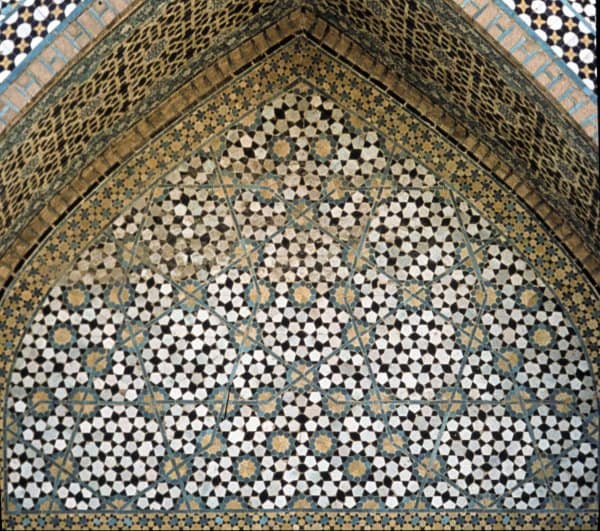
Islamic architects and mathematicians were creating quasi-crystalline patterns some 500 years before similar patterns were described in the West, claim two physicists in the US. Peter J Lu of Harvard University and Paul Steinhardt of Princeton University say that sets of special tiles developed around the 13th century allowed artisans to use complex mathematics to create the fantastic geometric patterns that adorn mosques, palaces and other buildings in the Muslim world. These patterns include “nearly perfect” Penrose patterns, which the researchers claim are similar to the first quasicrystals described in 1974 by the British mathematical physicist Roger Penrose (Science 315 1106).
Quasicrystals are patterns that fill all of space, but do not have the translational symmetry that is characteristic of true crystals. In two dimensions this means that sliding an exact copy of the pattern over itself will never produce an exact match (but rotating the copy will often produce a match). They were first described by Penrose in the guise of the famous Penrose tiles. About ten years later Danny Schechtman at Israel’s Technion University showed that the positions of atoms in a metallic alloy had a quasi-crystalline structure. Since then, hundreds of different quasicrystals have been discovered in nature
Penrose tiling is very reminiscent of “girih” – the elaborate patterns used in Islamic architecture. While travelling in Uzbekistan, Lu noticed motifs with 10-fold rotational symmetry, which is a hallmark of some Penrose tiling. This inspired him to search through thousands of photographs of Islamic patterns to try to find a quasi-crystalline pattern – and this led him to a wall of the Darb-i Imam shrine in Iran, built in 1453.
Although Lu describes the Darb-i Imam pattern as a “nearly-perfect” Penrose tiling, he told Physics Web that the defects could be removed by “flipping a few tiles”. He believes that the pattern’s designer had perfection in mind, but the pattern may have been distorted during construction or repair.

Creating a quasi-crystalline pattern would have required the application of a complex set of mathematical rules, seemingly beyond the grasp of the artisans that created the tiling. Lu says that Islamic mathematicians embodied their knowledge of quasicrystals into a set of five girih tiles of different shapes including a hexagon, bowtie and rhombus. Each tile is decorated with several lines, and when the tiles are laid edge-to-edge the lines connect to form a continuous pattern – something that Lu believes could be done by a worker with little mathematical training.
The researchers used different combinations of girih tiles to create a wide range of complex patterns including the Darb-i Imam pattern. They claim that the outlines of the five tiles can be seen in a 15th century scroll now held in a museum in Istanbul. The researchers also claim that the scroll and the Darb-i Imam shrine bear examples of how the tiles can be used to perform a “self-similarity transformation” to create overlapping patterns at different length scales – another example of how the tiles embody highly sophisticated mathematics.
This is not the first time that a link between girih and Penrose tiling has been made. In 1992 the Danish crystallographer Emil Makovicky published a claim that a pattern found elsewhere in Iran was Penrose tiling with several defects. However until Lu and Steinhardt’s work, scholars had believed that the creation of such patterns was accidental.



